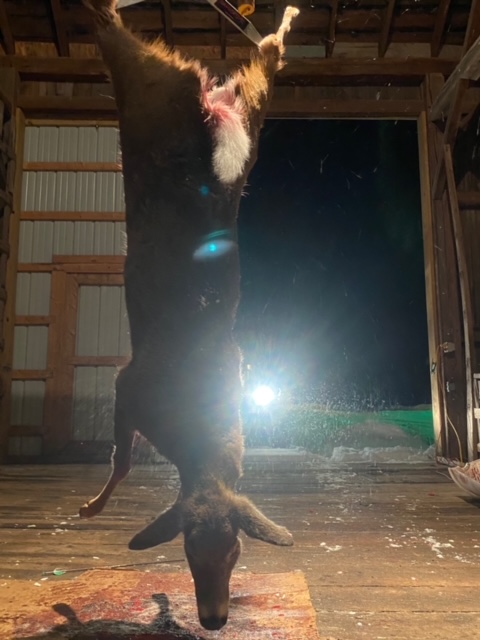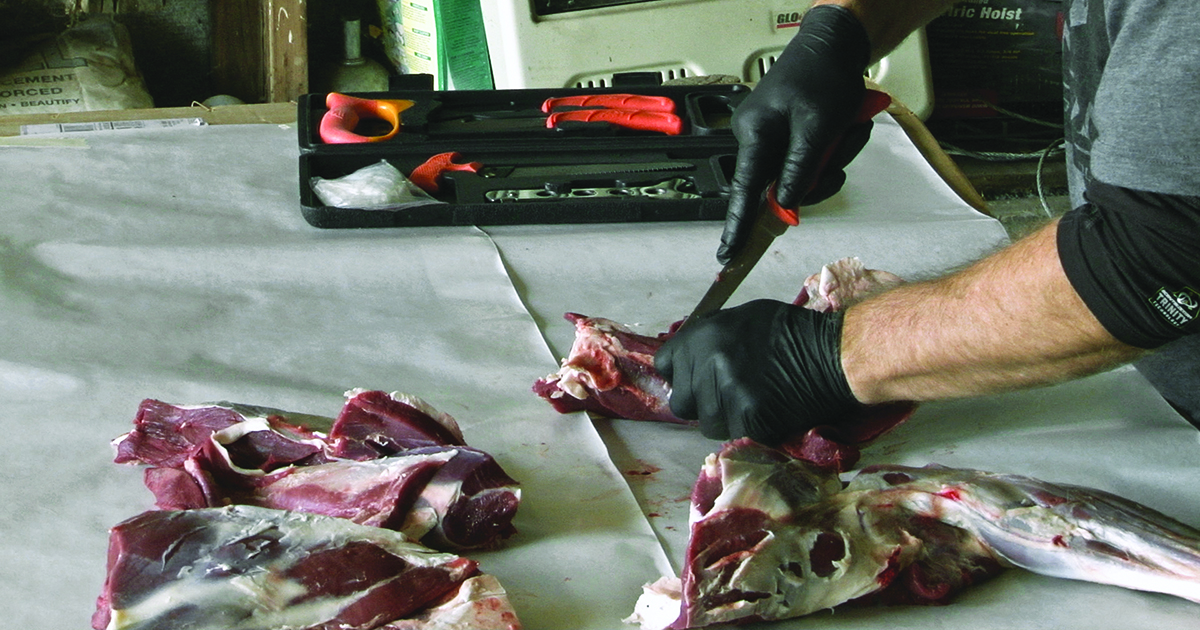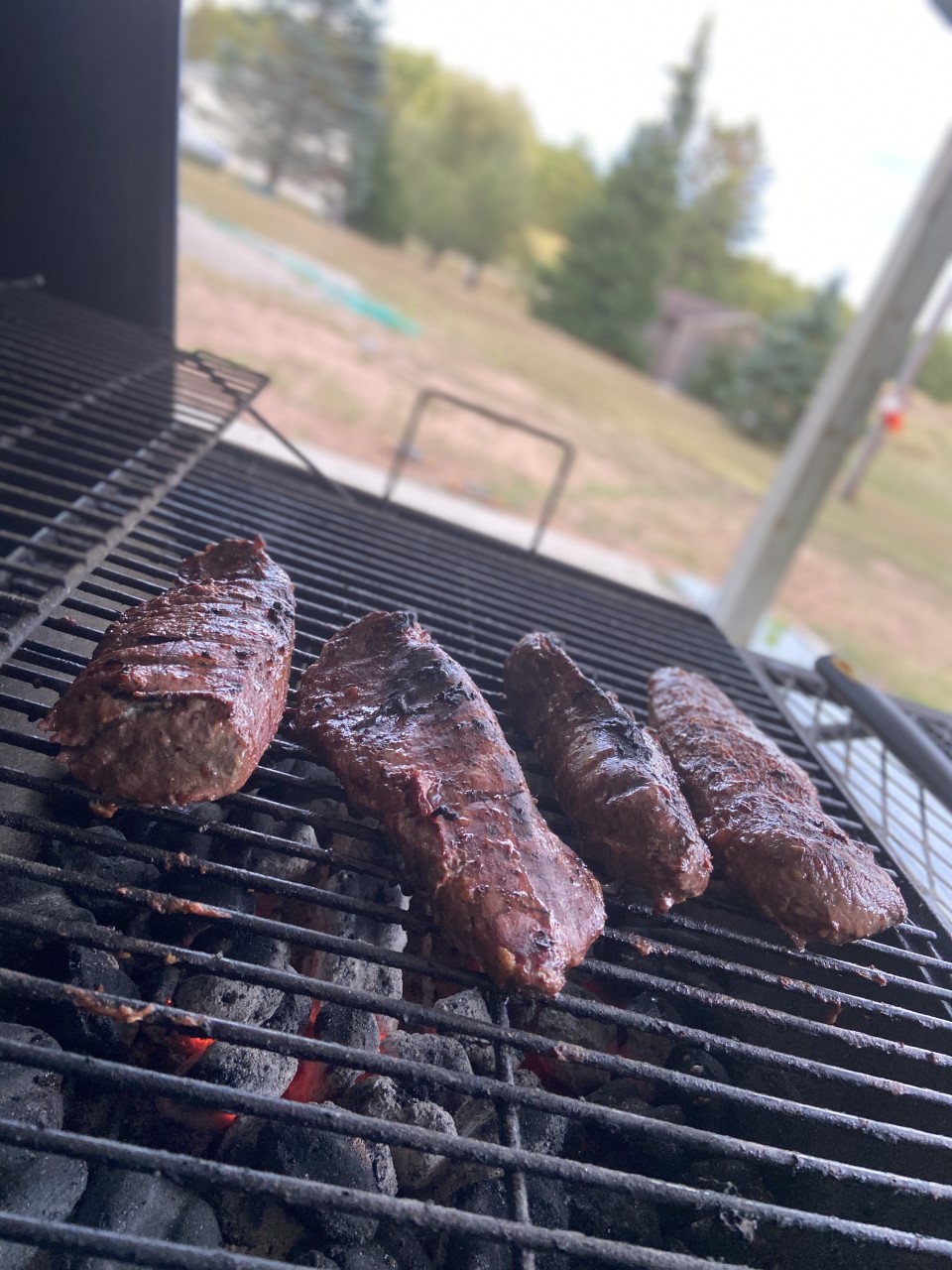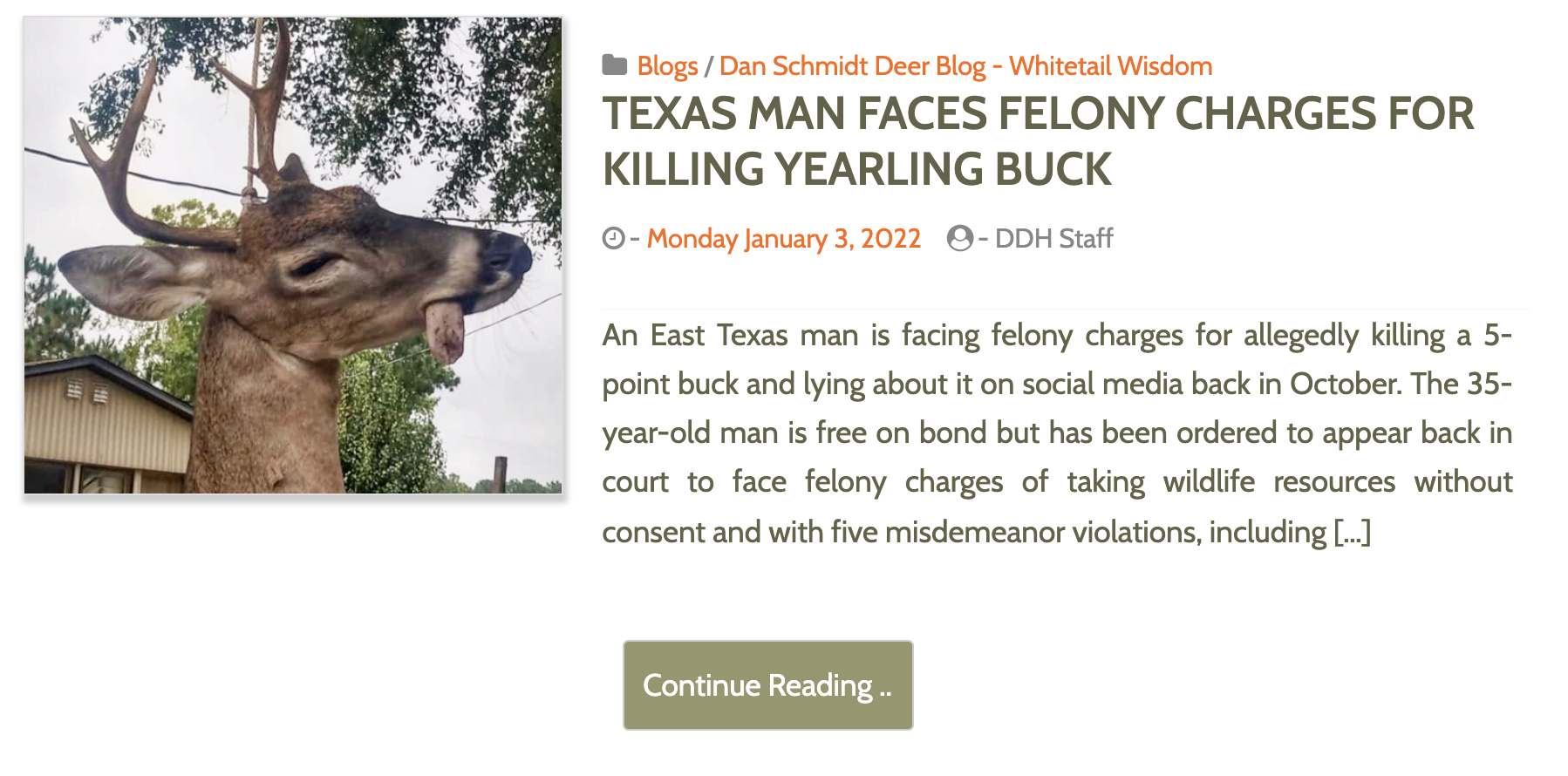Should you age your venison before butchering? If so, how long? Under what conditions? Why might aging venison matter? Let’s explore every aspect of hanging your whitetail before taking knife to meat.
It’s the symbol of a successful hunt, and a harbinger of great eating to come: A whitetail on the meatpole.
Whether I’m hunting out of some farmhouse on the prairie, a northwoods deer camp, a motel room in farm country or the familiar comfort of my own home, nothing warms my heart like stepping out into the starry night or my chilly garage and taking one more look at a whitetail I was lucky enough to bag that day.
But questions always arise as I stroke the thick, pepper-gray fur of an autumn or winter whitetail: What are the benefits of waiting to cut up the meat, versus finishing the job as soon as possible? Why do these factors matter to meat quality? How long should l let this deer hang? And if I’m going to let the meat age, what are the proper and safe conditions under which to it?
If you’ve pondered these important topics, all of which have a direct effect on the quality of the venison that reaches your table, here are some answers.
Aging Actions
After a deer dies, its muscles quickly enter a state of rigor mortis, defined literally from Latin as stiffness in death. The reason is really pretty simple: without oxygen feeding the muscle tissue anymore, the proteins present can no longer perform their maintenance work, and the muscles contract.
Rigor mortis has nothing to do with aging meat. It is just a natural process that sets in a couple hours after death. Within 12 to 24 hours though, the process will complete itself and the muscles (meat) will relax again. That’s when aging starts … and you should have that deer carcass cooled down when it happens.
Butchering and freezing a deer while it is in a state of rigor mortis is not a good idea because the contracted meat will stay that way: tough and taut. But what happens to meat when it ages?

There’s a little more science involved with aging meat and why it can be beneficial to the texture and taste of your final output. After rigor mortis has ended, enzymes begin to work break down those complex proteins present in the venison. Most important to break down are the proteins in the connective tissue – known as collagen – that is present between the meat fibers. This is a natural process that tenderizes meat.
Given the right conditions, which we will discuss, letting a deer age for some period of time will result in meat that is tenderer and should have better flavor.
It’s important to note that aging is not rotting. It takes bacteria to begin and carry out the deterioration process; given the cool conditions needed for proper aging, bacteria can’t live or begin to go to work.
Proper Conditions
If you’re going to age your venison, the process must take place under the proper conditions.
Temperature is the number one consideration. If your deer is hanging outside in temperatures below freezing, it is not aging. It is frozen. You will have to thaw it before butchering. You are better off not putting that meat through a freeze-thaw freeze cycle, though. Strive to hang your deer where it is cool, not cold.
The ideal temperature range for aging a deer is 36 to 40 F. The lower the temperature, the longer the deer can age. Many butchers recommend 36 F. Surroundings between 32 and 36 do the aging job pretty well, too, but slower.
If outdoor conditions match those temperature ranges (32 to 40 F or so), you are in good luck. But that’s often a lot to ask during deer seasons that range from sultry September to frigid December and January.
When conditions are too warm to hang your deer outside, there’s an easy way to age your deer that doesn’t involve finding a meat locker in which to hang the entire carcass.
To start, skin the deer and chunk it up into seven parts:
- Two hind quarters
- Two front quarters
- Two loins
- Bag of other trim meat you pull off
Then place the meat in a spare refrigerator set to 36 F for aging. This plan works just as well as hanging a whole carcass. To prevent the meat from drying out, wrap it in plastic wrap or place it in plastic bags. Note that this is also a great meat-aging when a carcass would freeze hanging outside, or even in your garage or a shed.
Speaking of hanging carcasses, here are a few important concepts to understand.
- If the deer has had a chance to cool, hanging it with the skin on is desirable because the skin holds moisture in and the meat won’t dry out.
- A deer is best hung by the gambrels (back legs). This also happens to be ideal positioning for skinning a deer later, and pulling off the meat too, for that matter.
- If you do skin the deer to give the meat a better chance to initially cool, place the carcass or quarters in cheesecloth bags for hanging. This will protect the meat from flies, and give it an extra measure of protection once a crust forms over the meat.
Here’s the bottom line for temperature considerations regarding aging. If that carcass is going to rise to a temperature above 40F for any portion of the day, you are giving bacteria the opportunity to go to work.
Next, consider how long to age the meat.
Timing Considerations
Every hunter seems to have their own opinion on how long to age a deer … or if it should even be aged at all! Certainly, delicious venison is processed each year from both ends of the length-of-aging spectrum. Here are a couple examples from my own experience.
Quite a few Novembers ago now, the gun season in southern Wisconsin was exceedingly warm, with daytime temperatures topping in the upper 50s. Our little hunting group that year consisted of me, my friend Ron, brother Larry, and my Dad.
The first day of the season was slow – hunters and deer just weren’t moving in the “heat.” So on the second day we went to work, doing some little pushes through brushy creekbottoms and shady north-facing sidehills. We moved whitetails, our aim was true, and at day’s end we had a pleasant quandary to deal with in the warm weather: Three whitetails down.
We skinned them by lantern light in my Dad’s backyard as the November night cooled temperatures into the thirties. The next morning, rigor mortis was done, so we butchered the deer in an assembly line, before the day got too warm. Maybe those deer would have been better with some aging, but we didn’t have too many options, as we all had to go our own separate ways in the afternoon. The venison was just fine, too.
On the other hand, quite a few Novembers ago now, I shot a nice young buck in Minnesota’s gun season. I didn’t have time to butcher the five-pointer before leaving for another hunt, so I took the deer to a trusted butcher.
I had a little trepidation when they said their main cooling room was full and they were going to store that deer in a refrigerated semi-trailer in their back lot. My concern wasn’t the surroundings: The trailer was clean as a whistle, refrigerated perfectly, and we hung the deer to boot.
But mine was the first one in. And it looked to me like first one in meant last one out.
I returned from Nebraska five days later, got busy with kids and work and life, and finally remembered to call the butcher on day 10 to pick up my meat. “We’re just getting to that one tomorrow,” was the reply.
Do you know what? That was the best deer I ever ate, bar none. Now it certainly didn’t hurt that the animal was a roly poly yearling. But the venison would literally melt in your mouth. While 11 days is a little longer than usually recommended for aging, I can’t argue with the results.

So how long should you age a deer? The answer is, it all depends. But here are some guidelines.
First off, older deer usually require more aging than younger deer, to get them to a tender state. The reason: Younger deer haven’t accumulated as much collagen in their muscles.
To a point, the longer you age a deer, the more tender it will get, as with my 11-day buck. Three to four days is about be the ideal amount of aging time that most butchers recommend, but seven days is fine and some meat cutters swear by ten. But remember, conditions must be ideal – in that 36 to 40 F range.
What if your schedule doesn’t allow you to wait that long? Maybe conditions are too warm outside, or life is going to get real busy, real fast, and you have to do the job when you have the time. In that case, at the very least, you should wait for the meat to cool down and rigor mortis to end.
If you have a deer that you’re going to completely grind for sausage, jerky, brats and other processed venison products, aging time is not as much a factor. While aging is fine on meat intended for these purposes, the physical act of grinding will take care of the tenderization work. But if you’re saving out delicious loins for boneless chops, and some chunks of prime cuts from back legs for steaks and roasts, age them in a refrigerator or cooler (see sidebar) for a few days before making the final cuts and freezing.
Conclusion
Given the right conditions – 36 to 40 F in a dry and clean environment – aging your venison for three to four days will improve the quality of the meat markedly. You can age a deer longer than that, but don’t let the meat dry out or you will lose tenderness and flavor. You can butcher your deer without aging if you want or need to, but make sure the carcass is cool and rigor mortis has ended.

Aging Venison in a Cooler
Do you hunt early seasons when it’s too warm to hang and age a deer? Coolers make great options for aging venison. Under the tightly closed lid of a good cooler, ice keeps venison at an almost ideal temperature for aging. Here are a few guidelines for making sure your meat ages properly.
Chunk up the deer. Quarter the deer into front shoulders, rear quarters, loins, and a bag of any trim.
Place ice in the bottom of the cooler. Don’t mix meat and ice. Place meat on top of the ice.
Keep the meat dry. If you let the meat soak in ice water, all the juices that make venison taste great will leach out. Instead, place the meat in plastic bags. Or, at least, place plastic over the ice in the bottom of the cooler so that meat and water can’t come in contact.
Drain water regularly. Drain out water daily, and add ice as you need to.
Flip the pieces. Every day, rearrange the meat so that a different part is in contact with the cold surface of the ice. This will help the meat age at the same rate.
You can age a venison in a cooler as well as you can a spare refrigerator. The cooler route just takes a little more work to keep the meat dry, the water drained, and the ice replenished.
Cooler aging is also great if you’re camping and hunting: Your meat will keep, and it’s aging at the same time. Getting ice may be the only issue. Plan ahead and know which town to run to for more ice.
Cooler aging can also work in frigid weather to keep extreme cold away from the meat so it doesn’t freeze. If a carcass hung outside is in danger of freezing, chunk out the deer and put in coolers without ice. Place coolers in a garage or shed where they’re not fully exposed to the elements.
D+DH In-Depth is our premium, comprehensive corner on America’s No. 1 game animal. In this graduate-level course, we’ll teach you about deer biology, behavior, and ultimately, how to become a better hunter. Want to be the first to get our premium content? Become a D+DH Insider for FREE!
Also check out this recent blog:













































